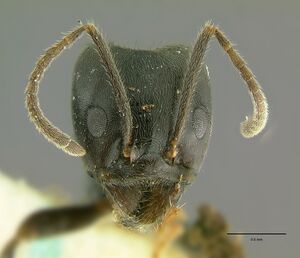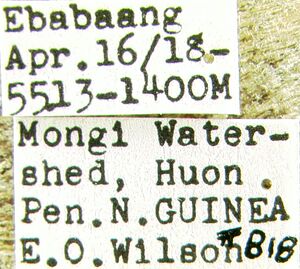Anonychomyrma anguliceps
| Anonychomyrma anguliceps | |
|---|---|

| |
| Scientific classification | |
| Kingdom: | Animalia |
| Phylum: | Arthropoda |
| Class: | Insecta |
| Order: | Hymenoptera |
| Family: | Formicidae |
| Subfamily: | Dolichoderinae |
| Tribe: | Leptomyrmecini |
| Genus: | Anonychomyrma |
| Species: | A. anguliceps |
| Binomial name | |
| Anonychomyrma anguliceps (Forel, 1901) | |
Identification
Distribution
Latitudinal Distribution Pattern
Latitudinal Range: -5.733° to -5.733°.
| North Temperate |
North Subtropical |
Tropical | South Subtropical |
South Temperate |
- Source: AntMaps
Distribution based on Regional Taxon Lists
Indo-Australian Region: New Guinea.
Distribution based on AntMaps
Distribution based on AntWeb specimens
Check data from AntWeb
Countries Occupied
| Number of countries occupied by this species based on AntWiki Regional Taxon Lists. In general, fewer countries occupied indicates a narrower range, while more countries indicates a more widespread species. |

|
Estimated Abundance
| Relative abundance based on number of AntMaps records per species (this species within the purple bar). Fewer records (to the left) indicates a less abundant/encountered species while more records (to the right) indicates more abundant/encountered species. |

|
Biology
Anonychomyrma species are common in moist to semi-arid forested areas (and are less common in rain forests). They nest either in soil with or without coverings, or arboreally in living or dead wood. Workers forage in conspicuous trails on the ground and on tree trunks. Although not studied in detail, they seem to be general predators and also collect plant juices. Some species are associated with the caterpillars of selected butterflies. Nest sizes are moderate to large, ranging from 500 to tens of thousands of workers. When disturbed, most species elevate their gasters and release strong, acrid smelling chemicals as a defensive measure. While similar to Iridomyrmex in general habitat preferences and ecology, most Anonychomyrma prefer moister sites and are predominately arboreal. Iridomyrmex species occur in drier sites and are predominantly terrestrial.
Castes
Worker
   
| |
| . | |
Nomenclature
The following information is derived from Barry Bolton's Online Catalogue of the Ants of the World.
- anguliceps. Iridomyrmex anguliceps Forel, 1901b: 18 (q.m.) NEW GUINEA (Papua New Guinea).
- Type-material: syntype queens, syntype males (numbers not stated).
- [Note: Shattuck, 1994: 3, cites 1q, 4m syntypes MHNG.]
- Type-locality: Papua New Guinea: Bismarck Archipelago, New Britain I., Ralum, 4.vi.1896, at light (F. Dahl).
- Type-depository: MHNG.
- Combination in Anonychomyrma: Shattuck, 1992a: 13.
- Status as species: Dahl, 1901: 13; Forel, 1911e: 283; Emery, 1913a: 24; Wheeler, W.M. 1935g: 35; Chapman & Capco, 1951: 188; Shattuck, 1994: 3; Bolton, 1995b: 66.
- Distribution: Papua New Guinea.
Description
References
- Cantone S. 2018. Winged Ants, The queen. Dichotomous key to genera of winged female ants in the World. The Wings of Ants: morphological and systematic relationships (self-published).
- Forel, A. 1901b. Formiciden aus dem Bismarck-Archipel, auf Grundlage des von Prof. Dr. F. Dahl gesammelten Materials. Mitteilungen aus dem Zoologischen Museum in Berlin 2: 4-37. (page 18, queen, male described)
- Shattuck, S. O. 1992a. Review of the dolichoderine ant genus Iridomyrmex Mayr with descriptions of three new genera (Hymenoptera: Formicidae). J. Aust. Entomol. Soc. 31: 13-18 (page 13, Combination in Anonychomyrma)
References based on Global Ant Biodiversity Informatics
- Dahl F. 1901. Das Leben der Ameisen im Bismarck-Archipel, nach eigenen Beobachtungen vergleichend dargestellt. Mitt. Zool. Mus. Berl. 2: 1-70.
- Emery C. 1913. Hymenoptera. Fam. Formicidae. Subfam. Dolichoderinae. Genera Insectorum 137: 1-50.
- Forel A. 1901. Formiciden aus dem Bismarck-Archipel, auf Grundlage des von Prof. Dr. F. Dahl gesammelten Materials. Mitt. Zool. Mus. Berl. 2: 4-37.
- Forel A. 1911. Die Ameisen des K. Zoologischen Museums in München. Sitzungsber. Math.-Phys. Kl. K. Bayer. Akad. Wiss. Münch. 11: 249-303.
- Janda M., G. D. Alpert, M. L. Borowiec, E. P. Economo, P. Klimes, E. Sarnat, and S. O. Shattuck. 2011. Cheklist of ants described and recorded from New Guinea and associated islands. Available on http://www.newguineants.org/. Accessed on 24th Feb. 2011.
- Shattuck S. O. 1994. Taxonomic catalog of the ant subfamilies Aneuretinae and Dolichoderinae (Hymenoptera: Formicidae). University of California Publications in Entomology 112: i-xix, 1-241.
- Viehmeyer H. 1912. Ameisen aus Deutsch Neuguinea gesammelt von Dr. O. Schlaginhaufen. Nebst einem Verzeichnisse der papuanischen Arten. Abhandlungen und Berichte des Königlichen Zoologischen und Anthropologische-Ethnographischen Museums zu Dresden 14: 1-26.
- Wheeler W.M. 1935. Check list of the ants of Oceania. Occasional Papers of the Bernice Pauahi Bishop Museum 11(11):1-56.
- Wheeler, William Morton.1935.Checklist of the Ants of Oceania.Occasional Papers 11(11): 3-56

